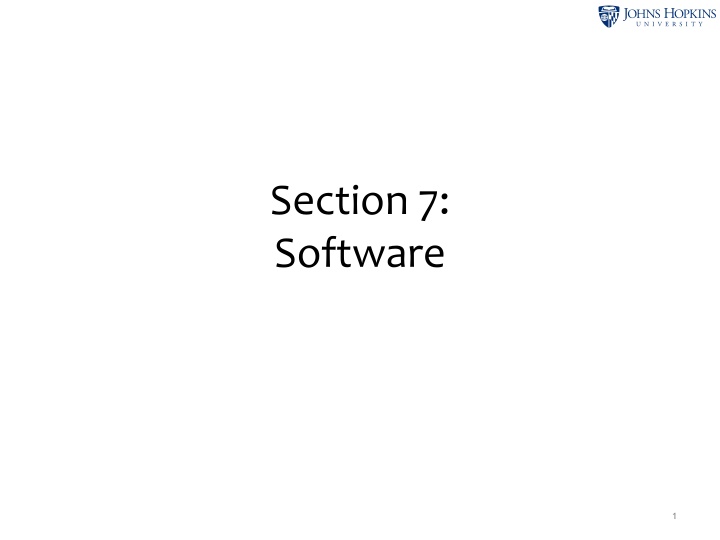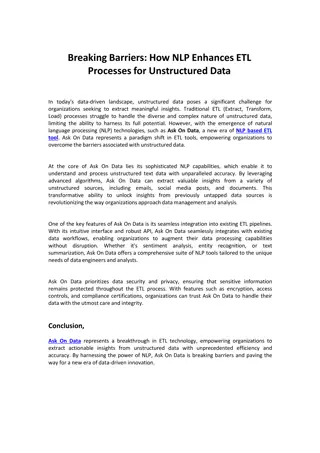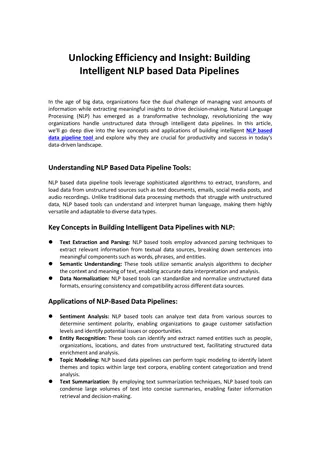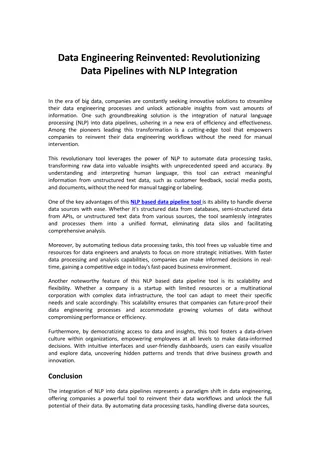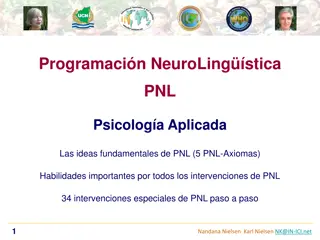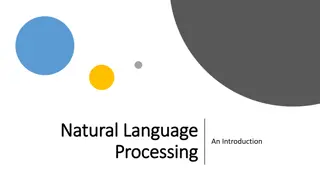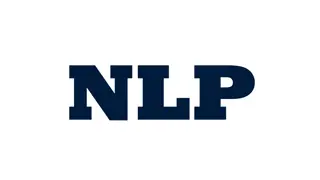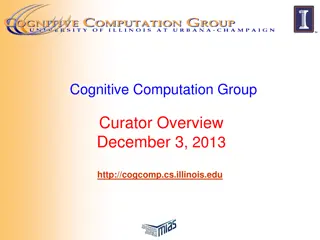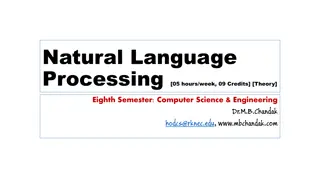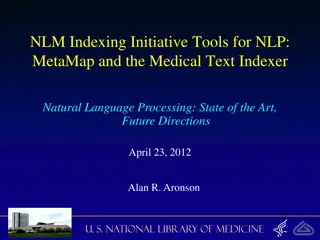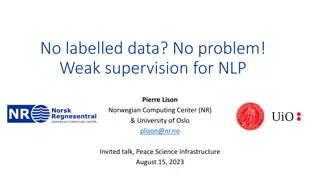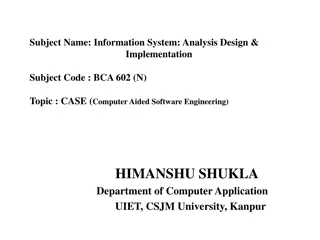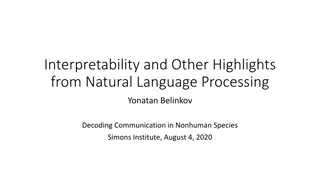Advanced NLP Models and Software Tools for Linguistic Analysis
Unveil the realm beyond traditional NLP models by delving into factor graphs, Belief Propagation (BP) algorithms, and sophisticated linguistic structures. Enhance your understanding of model building, tuning parameters, and dynamic programming algorithms within a single factor. Explore cutting-edge software tools like Pacaya and ERMA for structured inference and training on CRFs and MRFs. Dive into Graphical Models Libraries like Factorie and LibDAI for modular specification, inference methods, and learning settings. Elevate your NLP capabilities to new heights with this comprehensive tutorial.
Download Presentation

Please find below an Image/Link to download the presentation.
The content on the website is provided AS IS for your information and personal use only. It may not be sold, licensed, or shared on other websites without obtaining consent from the author.If you encounter any issues during the download, it is possible that the publisher has removed the file from their server.
You are allowed to download the files provided on this website for personal or commercial use, subject to the condition that they are used lawfully. All files are the property of their respective owners.
The content on the website is provided AS IS for your information and personal use only. It may not be sold, licensed, or shared on other websites without obtaining consent from the author.
E N D
Presentation Transcript
Section 7: Software 1
Outline Do you want to push past the simple NLP models (logistic regression, PCFG, etc.) that we've all been using for 20 years? Then this tutorial is extremely practical for you! 1. Models: Factor graphs can express interactions among linguistic structures. 2. Algorithm: BP estimates the global effect of these interactions on each variable, using local computations. 3. Intuitions: What s going on here? Can we trust BP s estimates? 4. Fancier Models: Hide a whole grammar and dynamic programming algorithm within a single factor. BP coordinates multiple factors. 5. Tweaked Algorithm: Finish in fewer steps and make the steps faster. 6. Learning: Tune the parameters. Approximately improve the true predictions -- or truly improve the approximate predictions. 7. Software: Build the model you want! 2
Outline Do you want to push past the simple NLP models (logistic regression, PCFG, etc.) that we've all been using for 20 years? Then this tutorial is extremely practical for you! 1. Models: Factor graphs can express interactions among linguistic structures. 2. Algorithm: BP estimates the global effect of these interactions on each variable, using local computations. 3. Intuitions: What s going on here? Can we trust BP s estimates? 4. Fancier Models: Hide a whole grammar and dynamic programming algorithm within a single factor. BP coordinates multiple factors. 5. Tweaked Algorithm: Finish in fewer steps and make the steps faster. 6. Learning: Tune the parameters. Approximately improve the true predictions -- or truly improve the approximate predictions. 7. Software: Build the model you want! 3
Pacaya Features: Structured Loopy BP over factor graphs with: Discrete variables Structured constraint factors (e.g. projective dependency tree constraint factor) ERMA training with backpropagation Backprop through structured factors (Gormley, Dredze, & Eisner, 2015) Language: Java Authors: Gormley, Mitchell, & Wolfe URL: http://www.cs.jhu.edu/~mrg/software/ (Gormley, Mitchell, Van Durme, & Dredze, 2014) (Gormley, Dredze, & Eisner, 2015) 4
ERMA Features: ERMA performs inference and training on CRFs and MRFs with arbitrary model structure over discrete variables. The training regime, Empirical Risk Minimization under Approximations is loss-aware and approximation-aware. ERMA can optimize several loss functions such as Accuracy, MSE and F-score. Language: Java Authors: Stoyanov URL: https://sites.google.com/site/ermasoftware/ (Stoyanov, Ropson, & Eisner, 2011) (Stoyanov & Eisner, 2012) 5
Graphical Models Libraries Factorie (McCallum, Shultz, & Singh, 2012) is a Scala library allowing modular specification of inference, learning, and optimization methods. Inference algorithms include belief propagation and MCMC. Learning settings include maximum likelihood learning, maximum margin learning, learning with approximate inference, SampleRank, pseudo-likelihood. http://factorie.cs.umass.edu/ LibDAI (Mooij, 2010) is a C++ library that supports inference, but not learning, via Loopy BP, Fractional BP, Tree-Reweighted BP, (Double-loop) Generalized BP, variants of Loop Corrected Belief Propagation, Conditioned Belief Propagation, and Tree Expectation Propagation. http://www.libdai.org OpenGM2 (Andres, Beier, & Kappes, 2012) provides a C++ template library for discrete factor graphs with support for learning and inference (including tie-ins to all LibDAI inference algorithms). http://hci.iwr.uni-heidelberg.de/opengm2/ FastInf (Jaimovich, Meshi, Mcgraw, Elidan) is an efficient Approximate Inference Library in C++. http://compbio.cs.huji.ac.il/FastInf/fastInf/FastInf_Homepage.html Infer.NET (Minka et al., 2012) is a .NET language framework for graphical models with support for Expectation Propagation and Variational Message Passing. http://research.microsoft.com/en-us/um/cambridge/projects/infernet 6
M. Auli and A. Lopez, A Comparison of Loopy Belief Propagation and Dual Decomposition for Integrated CCG Supertagging and Parsing, in Proceedings of the 49th Annual Meeting of the Association for Computational Linguistics: Human Language Technologies, Portland, Oregon, USA, 2011, pp. 470 480. M. Auli and A. Lopez, Training a Log-Linear Parser with Loss Functions via Softmax-Margin, in Proceedings of the 2011 Conference on Empirical Methods in Natural Language Processing, Edinburgh, Scotland, UK., 2011, pp. 333 343. Y. Bengio, Training a neural network with a financial criterion rather than a prediction criterion, in Decision Technologies for Financial Engineering: Proceedings of the Fourth International Conference on Neural Networks in the Capital Markets (NNCM 96), World Scientific Publishing, 1997, pp. 36 48. D. P. Bertsekas and J. N. Tsitsiklis, Parallel and distributed computation: numerical methods. Prentice-Hall, Inc., 1989. D. P. Bertsekas and J. N. Tsitsiklis, Parallel and distributed computation: numerical methods. Athena Scientific, 1997. L. Bottou and P. Gallinari, A Framework for the Cooperation of Learning Algorithms, in Advances in Neural Information Processing Systems, vol. 3, D. Touretzky and R. Lippmann, Eds. Denver: Morgan Kaufmann, 1991. R. Bunescu and R. J. Mooney, Collective information extraction with relational Markov networks, 2004, p. 438 es. C. Burfoot, S. Bird, and T. Baldwin, Collective Classification of Congressional Floor-Debate Transcripts, presented at the Proceedings of the 49th Annual Meeting of the Association for Computational Linguistics: Human Language Techologies, 2011, pp. 1506 1515. D. Burkett and D. Klein, Fast Inference in Phrase Extraction Models with Belief Propagation, presented at the Proceedings of the 2012 Conference of the North American Chapter of the Association for Computational Linguistics: Human Language Technologies, 2012, pp. 29 38. T. Cohn and P. Blunsom, Semantic Role Labelling with Tree Conditional Random Fields, presented at the Proceedings of the Ninth Conference on Computational Natural Language Learning (CoNLL-2005), 2005, pp. 169 172. 8
F. Cromier s and S. Kurohashi, An Alignment Algorithm Using Belief Propagation and a Structure-Based Distortion Model, in Proceedings of the 12th Conference of the European Chapter of the ACL (EACL 2009), Athens, Greece, 2009, pp. 166 174. M. Dreyer, A non-parametric model for the discovery of inflectional paradigms from plain text using graphical models over strings, Johns Hopkins University, Baltimore, MD, USA, 2011. M. Dreyer and J. Eisner, Graphical Models over Multiple Strings, presented at the Proceedings of the 2009 Conference on Empirical Methods in Natural Language Processing, 2009, pp. 101 110. M. Dreyer and J. Eisner, Discovering Morphological Paradigms from Plain Text Using a Dirichlet Process Mixture Model, presented at the Proceedings of the 2011 Conference on Empirical Methods in Natural Language Processing, 2011, pp. 616 627. J. Duchi, D. Tarlow, G. Elidan, and D. Koller, Using Combinatorial Optimization within Max-Product Belief Propagation, Advances in neural information processing systems, 2006. G. Durrett, D. Hall, and D. Klein, Decentralized Entity-Level Modeling for Coreference Resolution, presented at the Proceedings of the 51st Annual Meeting of the Association for Computational Linguistics (Volume 1: Long Papers), 2013, pp. 114 124. G. Elidan, I. McGraw, and D. Koller, Residual belief propagation: Informed scheduling for asynchronous message passing, in Proceedings of the Twenty-second Conference on Uncertainty in AI (UAI, 2006. K. Gimpel and N. A. Smith, Softmax-Margin CRFs: Training Log-Linear Models with Cost Functions, in Human Language Technologies: The 2010 Annual Conference of the North American Chapter of the Association for Computational Linguistics, Los Angeles, California, 2010, pp. 733 736. J. Gonzalez, Y. Low, and C. Guestrin, Residual splash for optimally parallelizing belief propagation, in International Conference on Artificial Intelligence and Statistics, 2009, pp. 177 184. D. Hall and D. Klein, Training Factored PCFGs with Expectation Propagation, presented at the Proceedings of the 2012 Joint Conference on Empirical Methods in Natural Language Processing and Computational Natural Language Learning, 2012, pp. 1146 1156. 9
T. Heskes, Stable fixed points of loopy belief propagation are minima of the Bethe free energy, Advances in Neural Information Processing Systems, vol. 15, pp. 359 366, 2003. T. Heskes and O. Zoeter, Expectation propagation for approximate inference in dynamic Bayesian networks, Uncertainty in Artificial Intelligence, 2002, pp. 216-233. A. T. Ihler, J. W. Fisher III, A. S. Willsky, and D. M. Chickering, Loopy belief propagation: convergence and effects of message errors., Journal of Machine Learning Research, vol. 6, no. 5, 2005. A. T. Ihler and D. A. McAllester, Particle belief propagation, in International Conference on Artificial Intelligence and Statistics, 2009, pp. 256 263. J. Jancsary, J. Matiasek, and H. Trost, Revealing the Structure of Medical Dictations with Conditional Random Fields, presented at the Proceedings of the 2008 Conference on Empirical Methods in Natural Language Processing, 2008, pp. 1 10. J. Jiang, T. Moon, H. Daum III, and J. Eisner, Prioritized Asynchronous Belief Propagation, in ICML Workshop on Inferning, 2013. A. Kazantseva and S. Szpakowicz, Linear Text Segmentation Using Affinity Propagation, presented at the Proceedings of the 2011 Conference on Empirical Methods in Natural Language Processing, 2011, pp. 284 293. T. Koo and M. Collins, Hidden-Variable Models for Discriminative Reranking, presented at the Proceedings of Human Language Technology Conference and Conference on Empirical Methods in Natural Language Processing, 2005, pp. 507 514. A. Kulesza and F. Pereira, Structured Learning with Approximate Inference., in NIPS, 2007, vol. 20, pp. 785 792. J. Lee, J. Naradowsky, and D. A. Smith, A Discriminative Model for Joint Morphological Disambiguation and Dependency Parsing, in Proceedings of the 49th Annual Meeting of the Association for Computational Linguistics: Human Language Technologies, Portland, Oregon, USA, 2011, pp. 885 894. S. Lee, Structured Discriminative Model For Dialog State Tracking, presented at the Proceedings of the SIGDIAL 2013 Conference, 2013, pp. 442 451. 10
X. Liu, M. Zhou, X. Zhou, Z. Fu, and F. Wei, Joint Inference of Named Entity Recognition and Normalization for Tweets, presented at the Proceedings of the 50th Annual Meeting of the Association for Computational Linguistics (Volume 1: Long Papers), 2012, pp. 526 535. D. J. C. MacKay, J. S. Yedidia, W. T. Freeman, and Y. Weiss, A Conversation about the Bethe Free Energy and Sum-Product, MERL, TR2001-18, 2001. A. Martins, N. Smith, E. Xing, P. Aguiar, and M. Figueiredo, Turbo Parsers: Dependency Parsing by Approximate Variational Inference, presented at the Proceedings of the 2010 Conference on Empirical Methods in Natural Language Processing, 2010, pp. 34 44. D. McAllester, M. Collins, and F. Pereira, Case-Factor Diagrams for Structured Probabilistic Modeling, in In Proceedings of the Twentieth Conference on Uncertainty in Artificial Intelligence (UAI 04), 2004. T. Minka, Divergence measures and message passing, Technical report, Microsoft Research, 2005. T. P. Minka, Expectation propagation for approximate Bayesian inference, in Uncertainty in Artificial Intelligence, 2001, vol. 17, pp. 362 369. M. Mitchell, J. Aguilar, T. Wilson, and B. Van Durme, Open Domain Targeted Sentiment, presented at the Proceedings of the 2013 Conference on Empirical Methods in Natural Language Processing, 2013, pp. 1643 1654. K. P. Murphy, Y. Weiss, and M. I. Jordan, Loopy belief propagation for approximate inference: An empirical study, in Proceedings of the Fifteenth conference on Uncertainty in artificial intelligence, 1999, pp. 467 475. T. Nakagawa, K. Inui, and S. Kurohashi, Dependency Tree-based Sentiment Classification using CRFs with Hidden Variables, presented at the Human Language Technologies: The 2010 Annual Conference of the North American Chapter of the Association for Computational Linguistics, 2010, pp. 786 794. J. Naradowsky, S. Riedel, and D. Smith, Improving NLP through Marginalization of Hidden Syntactic Structure, in Proceedings of the 2012 Joint Conference on Empirical Methods in Natural Language Processing and Computational Natural Language Learning, 2012, pp. 810 820. J. Naradowsky, T. Vieira, and D. A. Smith, Grammarless Parsing for Joint Inference. Mumbai, India, 2012. J. Niehues and S. Vogel, Discriminative Word Alignment via Alignment Matrix Modeling, presented at the Proceedings of the Third Workshop on Statistical Machine Translation, 2008, pp. 18 25. 11
J. Pearl, Probabilistic reasoning in intelligent systems: networks of plausible inference. Morgan Kaufmann, 1988. X. Pitkow, Y. Ahmadian, and K. D. Miller, Learning unbelievable probabilities, in Advances in Neural Information Processing Systems 24, J. Shawe-Taylor, R. S. Zemel, P. L. Bartlett, F. Pereira, and K. Q. Weinberger, Eds. Curran Associates, Inc., 2011, pp. 738 746. V. Qazvinian and D. R. Radev, Identifying Non-Explicit Citing Sentences for Citation-Based Summarization., presented at the Proceedings of the 48th Annual Meeting of the Association for Computational Linguistics, 2010, pp. 555 564. H. Ren, W. Xu, Y. Zhang, and Y. Yan, Dialog State Tracking using Conditional Random Fields, presented at the Proceedings of the SIGDIAL 2013 Conference, 2013, pp. 457 461. D. Roth and W. Yih, Probabilistic Reasoning for Entity & Relation Recognition, presented at the COLING 2002: The 19th International Conference on Computational Linguistics, 2002. A. Rudnick, C. Liu, and M. Gasser, HLTDI: CL-WSD Using Markov Random Fields for SemEval-2013 Task 10, presented at the Second Joint Conference on Lexical and Computational Semantics (*SEM), Volume 2: Proceedings of the Seventh International Workshop on Semantic Evaluation (SemEval 2013), 2013, pp. 171 177. T. Sato, Inside-Outside Probability Computation for Belief Propagation., in IJCAI, 2007, pp. 2605 2610. D. A. Smith and J. Eisner, Dependency Parsing by Belief Propagation, in Proceedings of the Conference on Empirical Methods in Natural Language Processing (EMNLP), Honolulu, 2008, pp. 145 156. V. Stoyanov and J. Eisner, Fast and Accurate Prediction via Evidence-Specific MRF Structure, in ICML Workshop on Inferning: Interactions between Inference and Learning, Edinburgh, 2012. V. Stoyanov and J. Eisner, Minimum-Risk Training of Approximate CRF-Based NLP Systems, in Proceedings of NAACL-HLT, 2012, pp. 120 130. 12
V. Stoyanov, A. Ropson, and J. Eisner, Empirical Risk Minimization of Graphical Model Parameters Given Approximate Inference, Decoding, and Model Structure, in Proceedings of the 14th International Conference on Artificial Intelligence and Statistics (AISTATS), Fort Lauderdale, 2011, vol. 15, pp. 725 733. E. B. Sudderth, A. T. Ihler, W. T. Freeman, and A. S. Willsky, Nonparametric belief propagation, MIT, Technical Report 2551, 2002. E. B. Sudderth, A. T. Ihler, W. T. Freeman, and A. S. Willsky, Nonparametric belief propagation, in In Proceedings of CVPR, 2003. E. B. Sudderth, A. T. Ihler, M. Isard, W. T. Freeman, and A. S. Willsky, Nonparametric belief propagation, Communications of the ACM, vol. 53, no. 10, pp. 95 103, 2010. C. Sutton and A. McCallum, Collective Segmentation and Labeling of Distant Entities in Information Extraction, in ICML Workshop on Statistical Relational Learning and Its Connections to Other Fields, 2004. C. Sutton and A. McCallum, Piecewise Training of Undirected Models, in Conference on Uncertainty in Artificial Intelligence (UAI), 2005. C. Sutton and A. McCallum, Improved dynamic schedules for belief propagation, UAI, 2007. M. J. Wainwright, T. Jaakkola, and A. S. Willsky, Tree-based reparameterization for approximate inference on loopy graphs., in NIPS, 2001, pp. 1001 1008. Z. Wang, S. Li, F. Kong, and G. Zhou, Collective Personal Profile Summarization with Social Networks, presented at the Proceedings of the 2013 Conference on Empirical Methods in Natural Language Processing, 2013, pp. 715 725. Y. Watanabe, M. Asahara, and Y. Matsumoto, A Graph-Based Approach to Named Entity Categorization in Wikipedia Using Conditional Random Fields, presented at the Proceedings of the 2007 Joint Conference on Empirical Methods in Natural Language Processing and Computational Natural Language Learning (EMNLP- CoNLL), 2007, pp. 649 657. 13
Y. Weiss and W. T. Freeman, On the optimality of solutions of the max-product belief-propagation algorithm in arbitrary graphs, Information Theory, IEEE Transactions on, vol. 47, no. 2, pp. 736 744, 2001. J. S. Yedidia, W. T. Freeman, and Y. Weiss, Bethe free energy, Kikuchi approximations, and belief propagation algorithms, MERL, TR2001-16, 2001. J. S. Yedidia, W. T. Freeman, and Y. Weiss, Constructing free-energy approximations and generalized belief propagation algorithms, IEEE Transactions on Information Theory, vol. 51, no. 7, pp. 2282 2312, Jul. 2005. J. S. Yedidia, W. T. Freeman, and Y. Weiss, Generalized belief propagation, in NIPS, 2000, vol. 13, pp. 689 695. J. S. Yedidia, W. T. Freeman, and Y. Weiss, Understanding belief propagation and its generalizations, Exploring artificial intelligence in the new millennium, vol. 8, pp. 236 239, 2003. J. S. Yedidia, W. T. Freeman, and Y. Weiss, Constructing Free Energy Approximations and Generalized Belief Propagation Algorithms, MERL, TR-2004-040, 2004. J. S. Yedidia, W. T. Freeman, and Y. Weiss, Constructing free-energy approximations and generalized belief propagation algorithms, Information Theory, IEEE Transactions on, vol. 51, no. 7, pp. 2282 2312, 2005. 14
